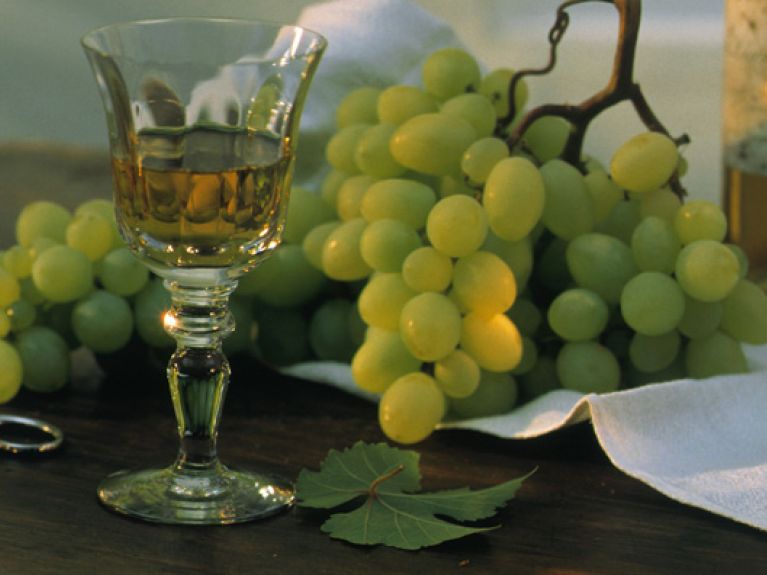Cultivating quality
Something is happening in German winegrowing – and often these innovations involve a return to time-tested products.

The secret of German wine
German vineyards along the Mosel, the Main, the Ahr, the Neckar and the Rhine can be breathtakingly steep, terrifyingly steep, hellishly steep. Anyone toiling away as a winegrower at these heights needs to be highly motivated, because wine can be produced quite easily with machines in flat locations at a fraction of the cost. Steep slopes demand considerable manpower and also lots of enthusiasts who will remain true to these wines for a variety of reasons. Are they so popular because they have a richer taste? Or is it because they contain far more minerals? Whatever the case may be, they have one thing in common: terroir.
And this very concept, which comes from France and means something like “origins”, only in a much broader sense, captures perfectly what is meant by the typicity of wine. It is a term that describes highly complex interactions. Terroir does not only tell you about the vineyard – about its slope and the direction in which it faces the sun, its soil and geology – but nowadays also encompasses the genetics of the vine, the age of the vines, the methods used in the vineyard and the cellar, and even the yeasts that thrive there. It is amazing how German winegrowers have worked to enhance the terroir over the past twenty years. There has been a quiet revolution in quality thanks to rigorous yield reductions, the re-introduction of old vines that bear fewer though more aromatic grapes, and improvements in expertise. In the process, a young generation of viticulturists is investing its energy in new – or rather – tried-and-tested methods by fermenting wines with natural yeasts instead of adding dry yeasts, and by using large old wooden barrels in which wines can mature harmoniously. In addition to Pinot blanc, Pinot gris, Silvaner, St. Laurent and Lemberger, two types of wine have benefited from these developments more than any others: Riesling and Spätburgunder.
Riesling alone is a cosmos in which millions of stars glow: it is available not only as dry as a bone, but also with a delicate sweetness. Prime locations that offer this variety a perfect home are crucial for Riesling.
Gateway to the Rheingau region. The Rheingau Riesling style was long dominated by the top wines of aristocratic landowners. Estates such as Schloss Vollrads, Schloss Reinhartshausen und Schloss Johannisberg stood for its unmistakable character. From 1950 on, the number of wines proliferated with the appearance of new varieties, artificial fertilizers and modern cellar technology. Suddenly, late vintages sprang up everywhere. Prices fell – and with them quality. That is, until the so-called glycol scandal occurred in 1985, triggering a wine crash in Germany. From then on, the small estates in the Rheingau region turned to quality instead of quantity and put their hopes in dry wines. In the meantime, they have become the pacemakers behind developments in the Rheingau and have redefined the Riesling style. In 1999, a classification system was also introduced, the Erstes Gewächs: only the best wines from the best locations are allowed to use this appellation on their label.
Top wines from steep slopes. The Saar and Mosel Riesling owes its style to three factors: a valley with extremely steep slopes, slate soils and a long vegetation period. Under these conditions, wines arise that are defined by their acidity, or as a sweet variation with an alcohol content of 7–8%, a powerful aroma and – thanks to the specific concentration of minerals – have a taste that lingers. The same is true of dry wines, although they call for a different way of thinking and working. Only when the winegrowers harvest late – waiting until November, for instance – do they harvest grapes that contain little acidity. Whether it is dry or contains residual sugar – Mosel Riesling demonstrates how elegant wines from a cooler climate can be. However, the best sign is that ever more leading winegrowers are returning to the old steep slopes, which are hard to cultivate.
Riesling newcomers. Alongside the Rieslings from Franken, those from the Pfalz have also gained in popularity. The wines from this region are powerful and steeped in fruit aromas reminiscent of grapefruit and apricot. At one time, Rheinhessen, Germany’s largest winegrowing region, mainly supplied the overseas market with the sweet Liebfraumilch. Nowadays, impressive Riesling wines are again growing in their original location: the vineyards of the Wormser Liebfrauenstift-Kirchenstück on the Rhine. And nearby, colourful butterflies displaying iridescent patterns emerge to drink – and when they silently open their wings, they display their full majesty.
Germany, land of red wine. Red grapes account for approximately 37% of the total – and their share is growing. The Spätburgunder occupies the top-quality spot, delivering excellent German craftsmanship in the production of wine. The Ahr valley is one of the world’s northernmost red-wine growing regions. On steep slate terraced vineyards, winegrowers cultivate fine, light Spätburgunder wines, which have caused a sensation across the globe. In 2008, the Meyer-Näkel vineyard, founded by an autodidact, was honoured with the international Pinot Noir Trophy by Decanter, the UK wine magazine.
Baden is the place for Spätburgunder. The Kaiserstuhl, in particular, offers ideal conditions for the high-quality variety, which benefits from the rich volcanic soil. Breisgau also produces excellent Burgunder. Thanks to the small quantities, the concentration of aromas increases, creating incredibly long-lasting wines. Spätburgunder also enjoys a very good reputation in the Pfalz. Individual, scattered terroirs produce surprising results. In Assmannshausen in Rheingau, Spätburgunder grows on a unique phyllite-rich soil. The red wine enclaves in Ingelheim in Rheinhessen, as well as those in Klingenberg and Bürgstadt in Franken, show just how wonderful Spätburgunder can turn out on limestone and red sandstone. As wine-drinkers, we are delighted with this new, colourful world of terroir. Terroir may be an abstract concept, but it can taste fantastic.

